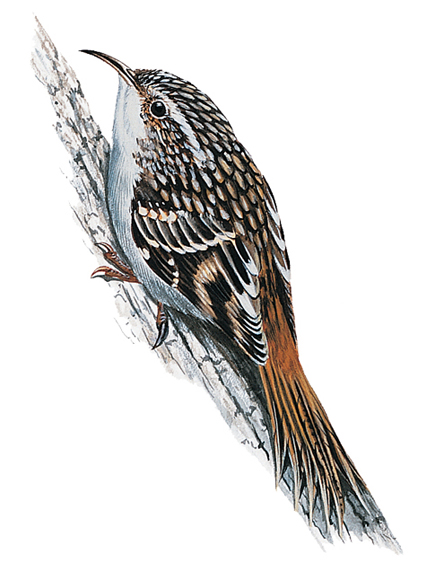The darkish creeper is quite oral, but its high-pitched vocalizations are easily skipped. It is usually individual, but it sometimes migrates and winter seasons with flocks of titmice, nuthatches, and kinglets. Polytypic (15 ssp.; 9 south of U. s. States-Mexico boundary ). Length 5.3" (13 cm).
Identification Unique appearance and looking conduct. Using its and female: similar plumage; male bigger. Mysterious upperparts streaked darkish, strong, and black; underparts light with warm rinse on flanks; rump strong, tawny, or rufous. Flight: wide, light side red stripe at base of trip down popular in trip.
Geographic Difference Subspecies south of the U. s. States-Mexico boundary split into 3 groups: american wildlife (alascensis, occidentalis, stewarti, phillipsi, zelotes, montana) are small, black, and long billed; southern wildlife (americana, nigrescens) are bigger, usually paler, and reduced billed; the Asian albescens, black with white distinguishing that differences more, expands into south Az and free airline New South the usa states. Rufous, darkish, and grey morphs in several numbers confuse recognition.
Similar Types None; vaguely just like some wrens, but appearance and conduct very different.
Voice Very high-pitched. Call: a soft, sibilant seee, usually buzzier and bending in american wildlife, tseeesee. Flight call: a short, vulnerable tsf; reduced and smoother than golden-crowned kinglet and chickadees. Song: diverse, but involves several paperwork, seee seeedsee sideeu. Eastern audio more complicated, quavering, and usually end on a higher note; american audio more stroking and often end on a low please take be aware.
Status and Submission Pretty common; unusual or unusual dog breeder in south part of range. Breeding: coniferous, combined, or swampy jungles. Maximum densities found in old-growth woodlands. Broader environment variety during migration and winter weather. Migration: person wildlife confuse prognosis of migrants in some areas. High overdue March–mid-April and October–November in Midwest/Northeast. Winter: much of Northern America.
Population Communities thought to have dropped throughout much of Northern America with the downing of old-growth jungles. Reproduction numbers outlined as vulnerable in The state of kentucky and as of special dilemma in some midwestern and southern declares.
Identification Unique appearance and looking conduct. Using its and female: similar plumage; male bigger. Mysterious upperparts streaked darkish, strong, and black; underparts light with warm rinse on flanks; rump strong, tawny, or rufous. Flight: wide, light side red stripe at base of trip down popular in trip.
Geographic Difference Subspecies south of the U. s. States-Mexico boundary split into 3 groups: american wildlife (alascensis, occidentalis, stewarti, phillipsi, zelotes, montana) are small, black, and long billed; southern wildlife (americana, nigrescens) are bigger, usually paler, and reduced billed; the Asian albescens, black with white distinguishing that differences more, expands into south Az and free airline New South the usa states. Rufous, darkish, and grey morphs in several numbers confuse recognition.
Similar Types None; vaguely just like some wrens, but appearance and conduct very different.
Voice Very high-pitched. Call: a soft, sibilant seee, usually buzzier and bending in american wildlife, tseeesee. Flight call: a short, vulnerable tsf; reduced and smoother than golden-crowned kinglet and chickadees. Song: diverse, but involves several paperwork, seee seeedsee sideeu. Eastern audio more complicated, quavering, and usually end on a higher note; american audio more stroking and often end on a low please take be aware.
Status and Submission Pretty common; unusual or unusual dog breeder in south part of range. Breeding: coniferous, combined, or swampy jungles. Maximum densities found in old-growth woodlands. Broader environment variety during migration and winter weather. Migration: person wildlife confuse prognosis of migrants in some areas. High overdue March–mid-April and October–November in Midwest/Northeast. Winter: much of Northern America.
Population Communities thought to have dropped throughout much of Northern America with the downing of old-growth jungles. Reproduction numbers outlined as vulnerable in The state of kentucky and as of special dilemma in some midwestern and southern declares.

No comments:
Post a Comment